
Paullinia is a genus of flowering shrubs, small trees and lianas in the soapberry family, Sapindaceae and typical of tribe Paullinieae. It is native to tropical South America, Central America and the Caribbean.

Echinodorus, commonly known as burhead or Amazon sword, is a genus of plants in the family Alismataceae, native to the Western Hemisphere from the central United States to Argentina. Its scientific name is derived from Ancient Greek echius – "rough husk" - and doros – "leathern bottle" - alluding to ovaries, which in some species are armed with persistent styles, forming prickly head of fruit. Some of the species are commonly cultivated in artificial aquatic habitats.
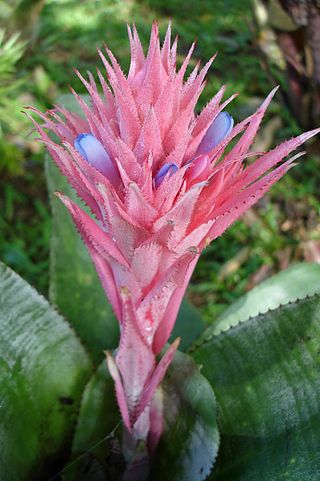
Aechmea is a genus of flowering plants in the family Bromeliaceae. The name comes from the Greek aichme, meaning "spear". Suggested pronunciations include EEK-me-ə and eek-MEE-ə. Aechmea comprises eight subgenera and around 250 species distributed from Mexico through South America and the Caribbean. Most of the species in this genus are epiphytes.

Setaria is a widespread genus of plants in the grass family. The name is derived from the Latin word seta, meaning "bristle" or "hair", which refers to the bristly spikelets.
Pimenta ferruginea is a species of flowering plant in the family Myrtaceae. It is endemic to Cuba.
Quiina jamaicensis is a species of plant in the family Ochnaceae. It is endemic to Jamaica.
Reynosia is a genus of plant in family Rhamnaceae. Darlingplum is a common name for this genus.
Trichilia trachyantha is a species of flowering plant in the family Meliaceae. It is endemic to Cuba.
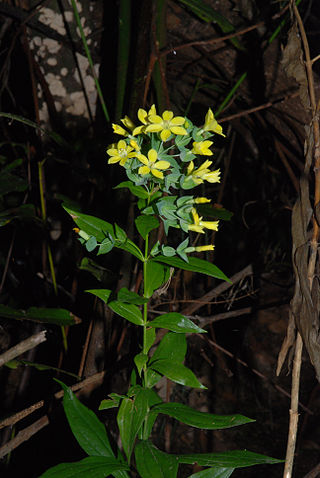
Ixanthus is a monotypic plant genus in the family Gentianaceae. The sole species, Ixanthus viscosus, is endemic to Canary Islands laurel fields and displays small yellow flowers when in bloom.
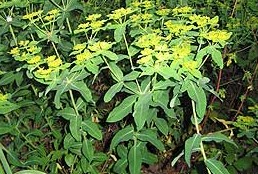
Euphorbia oblongata is a species of flowering plant in the family Euphorbiaceae. It is a spurge known by the common names Balkan spurge, eggleaf spurge and oblong spurge. It is native to Eurasia but can be found elsewhere as a weedy introduced species. This is a hairy perennial herb growing to maximum heights of just over half a metre. It has oval-shaped or narrow leaves with finely toothed edges which are 4 to 6 centimetres long. The foliage is green to yellow-green. The inflorescences hold tiny glandular flowers. The fruit is a spherical capsule about half a centimetre long which contains smooth brown seeds.
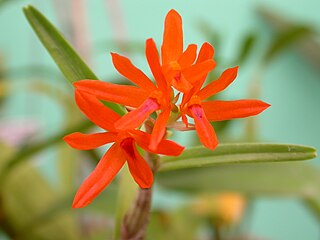
Scaphyglottis is a genus of orchids native to Mexico, Central America, northern South America and parts of the Caribbean. The current concept of this genus is the result of combining several genera which have been described at various times. The concept is characterized by the growth habit: not only are new pseudobulbs added at the base of the old ones, but new pseudobulbs also grow at the apices of the old ones. Many species are quite similar and difficult to distinguish, but some are clearly distinct. A few have showy colors. The genus comprises nearly 70 species.
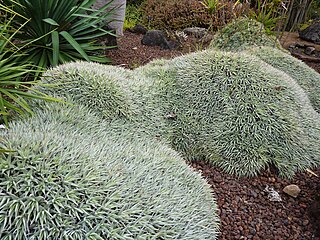
Deuterocohnia brevifolia is a species of plant in the family Bromeliaceae. This species is native to Argentina and Bolivia, but is also popular as a potted houseplant or ground cover elsewhere. A terrestrial species, it prefers sun or light shade and can grow in large dense mats of leaves given proper conditions.
Dorstenia petraea is a species of flowering plant in the family Moraceae. It is native to eastern Cuba.
Dorstenia crenulata is a species of flowering plant in the family Moraceae. It is native to Cuba.
Dorstenia tuberosa is a plant species in the family Moraceae. It is native to Cuba.

Cayaponia is among the largest genera in the gourd family, Cucurbitaceae, with 74 species. The plants are referred to as melonleaf. They are common from the southern United States to South America. Some species are also found in western Africa, Madagascar, and Fernando de Noronha, which is about 354 km (220 mi) off the coast of Brazil.
Haenianthusis a genus of flowering plant in the family Oleaceae. It is native to the Greater Antilles of the Caribbean. It contains 3 species:
- Haenianthus incrassatus(Sw.) Griseb. - Jamaica
- Haenianthus salicifoliusGriseb. - Cuba, Hispaniola, Puerto Rico
- Haenianthus variifoliusUrb. - Cuba

Neocogniauxia monophylla is a species of flowering plant in the subfamily Epidendroideae, and family Orchidaceae. It grows in Jamaica from elevations of 3,300 to 5,300 ft.

Rhynchocorys is a small genus of flowering plants belonging to the family Orobanchaceae. It was formerly classified in the family Scrophulariaceae.
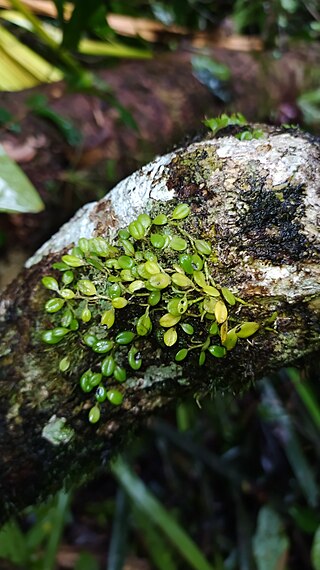
Anathallis polygonoides is a species of flowering plant in the family Orchidaceae. It is native to Trinidad and Tobago.












